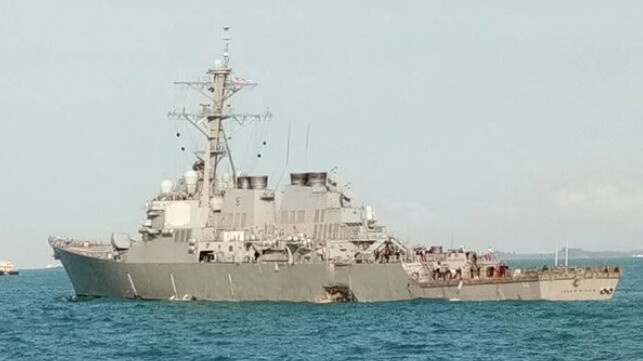US Navy 80% Responsible for 2017 Collision, Tanker Owner to Pay $45M

The United States was assigned 80 percent of the responsibility for causing a deadly 2017 collision between the guided missile destroyer USS John McCain and a Liberian-registered oil tanker Alnic MC in the Singapore Strait according to a decision filed on June 15 by a U.S. District Court Judge in the Southern District of New York. In this 70-page decision, the judge reconstructs the minutes leading up to the collision as he sought to apportion liability for the collision and calculates the respective damages for the U.S. Navy and the tanker’s owners Energetic Tank.
The court decided to split the long-running case into two phases, with the first phase heard last November in a bench trial presided over by U.S. District Court Judge Paul Crotty. Based on this decision handed down yesterday, the case will proceed to a second phase where the court will then adjudicate the personal injury and wrongful death claims by the sailor-claimants against the shipping company.
The shipping company had sued in 2018 seeking to limit the compensation for any claims filed by the Navy, injured sailors, or the families of sailors who died in the collision to more than the $16.7 million value assigned to the tanker and her cargo. Energetic Tank sought to place blame for the accident entire on the U.S. Navy and the crew of the destroyer. While the Navy has admitted partial responsibility for the accident, they argue that the tanker played a role in the collision while the survivors and families of the 10 sailors killed when compartments on the McCain flooded argued the collision was entirely avoidable.
The court ruled that the McCain was primarily at fault for “creating a scenario where collision between the vessels was either inevitable, or all-but inevitable. However, Alnic bears significant blame for its failure to take any meaningful action to minimize the carnage caused by the collision.” The judge also considered efforts by the tanker’s operators at a cover-up and false statements in their defense.
The judge denies Energetic Tank’s petition for limitation of the liability and its petition for exoneration. Instead, using the $185 million damages to the McCain and 450 days it took to repair the warship, along with the $442,445 in damages to the Alnic, the judge ordered the tanker company to pay the United States $44.6 million.
“The rich trove of data from both vessels played an important role at trial. It helped to reassemble, second-by-second, exactly how the collision happened,” writes judge Crotty in his ruling. The decision constructions a moment-by-moment account of the events leading up to the collision.
Early on August 21, 2017, the USS John McCain was behind schedule and increased speed to 20 knots while navigating the busy shipping lane heading for a regularly scheduled port visit. Captain Alfredo Sanchez who was commander of the McCain, decided to overtake a group of slower moving commercial vessels including the Alnic, which was operating at 9.6 knots. Before reaching the vessels, the commander testified that he ordered transfer of thrust control to the lee helm so that the helmsman “could focus on steering, particularly given McCain’s proximity to nearby vessels.” An examination of the records reveals that only port thrust control was transferred and the vessel immediately went out of control. Confusion ensued on the bridge as the officers and sailors attempted to determine the problem and regain control.
The destroyer signaled its loss of control but the tanker failed to take appropriate evasive actions. Later they made false statements saying they had ordered a stop but in fact never ordered a stop and only ordered slower speeds when they observed the McCain.
Aboard the McCain, they were left to navigate the vessel with the ship’s Integrated Bridge and Navigation System, which the court refers to in its decision as “new, glitchy, and unwieldy, complicating McCain’s ability to navigate.”
The court denied the United States' contention that the Alnic was 70 percent to blame instead saying that the McCain’s crew acted negligently by deciding not to stop outright after they had lost control of steering. “Despite his awareness of severe problems on the bridge, Commander Sanchez ordered the destroyer to continue forward at around 10 knots—still faster than many nearby vessels …. The crew had at least three minutes to press the All Stop button, which was available in plain sight on the IBNS touchscreen.” While noting it would not have been an immediate stop, the court cites the captain who said the vessel has impressive stopping power.
“There is no question McCain created the situation of danger in the Singapore Strait,” writes the judge. “The improper use of steering and thrust was entirely preventable.” The court also find that there was a longstanding lack of training for the McCain’s crew that sparked the confusion on her bridge and fueled the mistakes leading up to the collision.
The court also cites a list of problems with the Alnic leading to its decision to assign 20 percent of the blame to the tanker. Judge Crotty says the vessel’s bridge was improperly staffed hampering its ability to assess the situation and take steps to avoid the collision. He says the tanker could have slowed or turned away from the McCain. “Alnic’s most inexcusable fault, though, was her failure to do anything to mitigate the damage after colliding with McCain,” the judge writes while also citing false logs and statements. “The crew’s subsequent cover up confirms the apportionment of Alnic’s fault.”
Having concluded that Energetic Tank shall not be exonerated from liability, the court will proceed to the wrongful death and personal injury claims against the tanker company in phase two of the trial.
